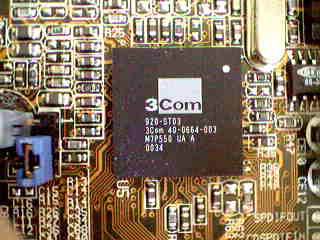ASUS CUV266 Socket-370 Apollo Pro 266 ATX
by Mike Andrawes on April 18, 2001 12:50 AM EST- Posted in
- Motherboards
Pluses and Minuses
As the market gets more and more competitive, many manufacturers are trying to distinguish their boards from the rest of the crowd by including a variety of unique features. As such, an on-board IDE RAID controller is practically standard on a high-end board targeted at enthusiasts, while special diagnostic tools are also quite popular.
ASUS noticed these trends and decided to take a slightly different route by integrating an Ethernet controller. This is not entirely unheard of, and at one point, it actually looked like this would become a standard feature as networks have become much more common. ASUS always focuses on quality, so it’s no surprise that they went with a highly regarded name for the on-board Ethernet controller. In this case, it’s 3Com’s 3C-920 10/100Mbps controller. The controller chip is located behind the fourth PCI slot, and the Ethernet port is placed above the two USB ports within the ATX I/O panel. Unfortunately, ASUS did not include a special I/O shield with our sample, but we fully expect the shipping version to include one, but have not been able to confirm this fact with ASUS.
What is strange, however, is that VIA already has integrated 10/100 Ethernet in the 8233 South Bridge that is used on the CUV266. Why ASUS has chosen to go with an external control anyway is beyond us, but something that we’ve seen them do numerous times in the past with i815E boards, which also feature Ethernet in the ICH2.

3Com 10/100Mbps Ethernet controller chip

Ethernet port in the ATX I/O panel
Besides the excellent performance we have come to expect from ASUS products, their outstanding quality and stability are actually what makes their boards so popular. The CUV266 was no exception, as stability was very impressive during our testing. With a CAS latency of two and no memory interleaving, the system was rock solid and didn’t crash once in 24 hours. Recall that our Gigabyte GA-6RX was not stable at all at CAS2 with memory interleaving enabled, but that’s not the case here. With either two-bank and four-bank interleaving enabled, the CUV266 was still pretty solid, albeit not quite as good as without memory interleaving - we experienced two crashes during 24 hours of stress testing, still quite impressive compared to most other motherboards.
Unfortunately, we did run into a few problems with the CUV266, the biggest of which was with AGP 4X. With it enabled, the system would crash every time we installed the video driver. By dropping back to AGP 2X and using the latest VIA 4.29v 4-in-1 driver, the problem was solved. Luckily, AGP 4X does not offer much benefit over AGP 2X, and we did not notice a significant performance hit. Nevertheless, there’s clearly something wrong here and such a problem should not exist. Hopefully this can be corrected with a BIOS update.
Furthermore, we were actually a little bit disappointed that ASUS did not include on-board IDE RAID controller, which would have made this board a truly exceptional one.
ASUS has always had one of the best manuals among motherboard manufacturers. Although there was no manual included with our early sample, we fully expect to see the excellent ASUS manual that we’re used to, containing almost every piece of information you need about the motherboard, ranging from how to setup the board to install drivers, and from jumpers to BIOS settings.










0 Comments
View All Comments